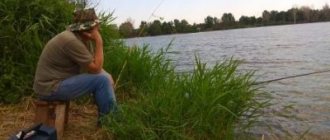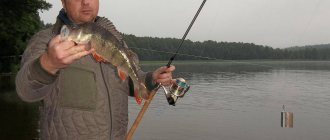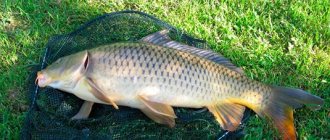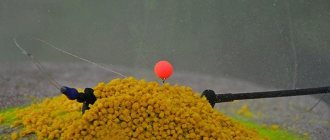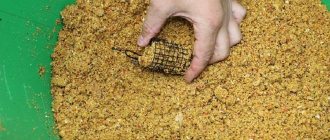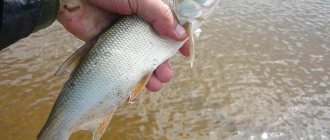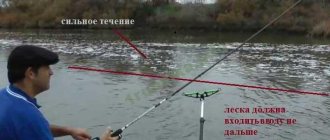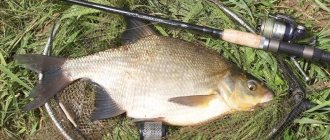For feeder fishing, different feeders are used. Flat fishing using the feeder method involves using a flat variety. This determines the peculiarities of bait preparation and fishing tactics. Usually such fishing is practiced in still waters, but sometimes it is also caught in the current.
What is flat feeder fishing? This is a method of fishing with a flat feeder. It has a lower loaded part in the form of a plane, and an open part on top, from which food is washed out. The flat bottom does not sink on the silty bottom and allows feed to be washed onto its surface.
As you know, the flat feeder came from carp fishing. Carp tackle has several fundamental differences from feeder tackle:
- The feeder is attached to the leadcore. This gives a good presentation, it lays flat on the muddy bottom clearly.
- The leash is rigidly attached using a swivel to the feeder through a connector. The fish does not have free movement, and when biting, it is forced to pull the feeder off the bottom. In most cases, self-cutting occurs.
- When fishing, a hook with a boilie and a hair rig is used. This is the main feature that distinguishes carp fishing from any other.
- When casting, the hook is inserted into the filled feeder. This prevents the leash from tangling during casting.
- After the feeder has sunk to the bottom, the food is washed out. The boilie, freed from food, floats up and remains in an upright position. So it is clearly visible to fish.
History of appearance
Boilie fishing originated in England. The nozzle and the hook in it are connected with hair, the hook hangs in the water column separately from the nozzle. This setup allows the carp to eat the bait and then swallow the hook. If the hook is inside the boilie, then the carp can spit it out, sensing a foreign body. There are strong suspicions that this kind of fishing originates in China. Carp is the most typical inhabitant of rivers and lakes there.
Tackle with a separated hook and nozzle was described in the almanac “Fisherman-Sportsman” in the article “Catching carp with a line”, where it is indicated that on the Amur, Iman, and Ussuri rivers, local residents catch carp in this way. The British could well have adopted the fishing method from the Chinese, having become acquainted with it during the Opium Wars. The article describes the biting mechanism in great detail - the carp takes the bait into its mouth on a hook tied to a hook, then it swallows it, and throws the hook over the gills, like a foreign body, and sits on it very securely.
Lure
Feeders for fishing on a flat feeder allow you to use two types of bait - regular and viscous. Regular baits are stuffed into the feeder after each cast. In this case, you can use either a mold or simply fill in the food by hand. If a hook with bait is placed in a feeder, then it is installed before driving into the widened groove between the ribs. Then, using your hand or a mold, take the bait and clamp it onto the feeder. After this, casting is performed.
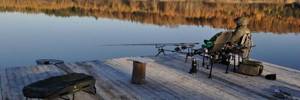
Viscous bait allows you to make more than one cast with the feeder without stuffing. This consistency allows you to save a lot on bait and is suitable for thrifty fishermen. True, to attract fish, you will have to do a generous starting feeding with a slingshot or by hand, so that a large feeding spot will attract fish from a long distance. Viscous baits are more convenient to use with banjo-type feeders, since in them the viscous food is held especially securely and allows you to make more casts.
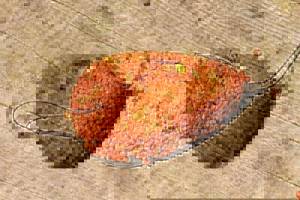
Bait is used both regular and special for fishing on a flat feeder. For regular fishing, it is closed by adding a small amount of water. To prepare viscous bait, add more water, and add a thickener to it, for example, molasses or potato starch. It is quite possible to prepare bait yourself using porridge, breadcrumbs, pea flour, semolina and other ingredients. Since the main objects of fishing using the flat method are carp and crucian carp, their preferences for different bodies of water are different, you need to try and experiment, these fish are quite picky and picky in their tastes.
Fish safety
One of the main advantages of the flat feeder rig is that it is completely safe for fish. Even if the gear with the inline feeder breaks, the fish will be able to free themselves from it and will not receive serious damage. The presence of icecore is mandatory for safe fishing, as is hair equipment. So everyone who is interested in not injuring the fish needs to adhere to these simple rules.
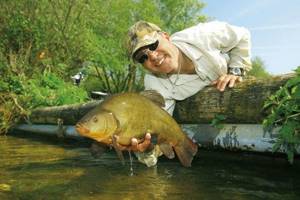
In Western European countries, fishing has long been cultivated according to the catch-and-release principle, which allows maintaining the number of large fish in rivers and lakes. But in our country, an increasing number of anglers, and in particular flat feeders, prefer to adhere to this principle. This gives hope that future generations will get involved in fishing and catch trophy carp and grass carp, including on flat feeders.
Use of pellets
The use of pellets in bait allows you to achieve good results. They are especially good with viscous baits. Pellets are released from the feeder as the feed gets wet and fall out. The shedding process itself is accompanied by the release of a cloud of turbidity in the water, bubbles, which additionally tempts the fish. During this process, a portion of the smell of bait is released into the water column. Pellets can also be placed on a hook as a bait, or as a component for a two-component bait.
Method flat feeder elasticated accessories
In addition to in-line equipment, there are also installations with a feeder, which is connected to the main line, for example, with a small fastener, and the leash is already installed on a special ring attached to the shock absorber (as a rule, this is a piece of plug rubber - photo 15A ). This shock absorber either passes through the leg of the feeder itself and is attached to its base, or is installed at the base of the feeder leg and is located in the middle of the feeder (photo 15B) . Such equipment is appropriate if a cord is used as the main fishing line - after all, it perfectly absorbs the jerks of strong fish, protecting the tackle from breakage.

Catching
The main feature of fishing on a flat feeder is the active search for fish. At the beginning of fishing, several promising fishing areas are found at once. Since fishing takes place on a silty bottom, often covered with algae, it can be difficult to study it with a marker weight. Therefore, it is best to use an echo sounder, a boat, or simply swim in the pond in the summer heat, looking for where there are gaps between the vegetation and holes that are convenient for fishing. Then identify several fishing spots. It is advisable to select a place for fishing so that you can fish these points without crossing the shore, from one place, changing the vector and casting distance. It can be convenient to put the points themselves on a sheet of paper, noting the distance to them and a landmark.

After this, start feeding is done. When fishing on the flat, it is more convenient to do it with a slingshot, since the method feeder itself does not imply the possibility of changing it to a feeding one. In this case, however, you can install a marker float so that feeding is done most accurately. A large amount of soil is added to the starter feed - up to seventy percent. The important thing here is not to feed the fish, but to create a smell and a visible spot on the bottom from a distance. They feed all promising points at once and begin fishing.
The leash is usually placed already at the fishing spot. Attach a boilie or a regular bait in the standard way. They cast, the feeder is slightly pulled towards itself after it has fallen to the bottom. This is necessary both to start washing out the food and to ensure that the feeder, if it is stuck into the ground with its edge, takes a horizontal position. If this does not happen, the hook with the boilie attached inside the feeder may get stuck and not float up.
Flat mounting options
The standard option for flat equipment for feeders is blind installation. However, in some fishing conditions other types of equipment are used.
Rigging methods:
- Deaf;
- Sliding;
- On an elastic band.

Blind flat equipment
Standard flat feeder equipment in a blind version is used in most cases. The remaining options are an exception for specific fishing conditions. At distances over 30 meters, especially if there is a lot of algae and grass in the water, on which the fishing line rests and, accordingly, does not go straight from the quiver tip to the feeder, we always use blind installation. In the sliding version of installation in such conditions, neat fish bites may simply not be seen, and self-hooking does not occur, since the line in this case will be pulled through the feeder. The fish will often spit out the hook.
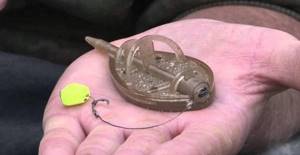
Initially, store-bought flat feeders were designed for blind equipment. The swivel or quick release for the leash fits firmly into the groove and is securely fixed in it. This is enough for the fish, when biting, to lift the feeder and be caught under its weight.
Video equipment flat method from Fadeev:
Sliding mounting equipment
It makes sense to use a sliding installation of a flat feeder for careful fishing with light feeders at a distance of no more than 30 meters. On such a short distance, especially if braid is used as a base, bites are transmitted well to the quivertip. Such installation requires constant monitoring of the tackle and hooking when bending the quiver tip after several pokes, or while pulling, if it occurs immediately. At close range, light feeders of 20-30 grams are often used. With such a small weight, when the flat feeder method is firmly mounted, self-hooking may not occur (if the fish does not make a sharp jerk, but simply swims away slowly). This is why tackle control and hooking are required.
To implement such an installation, a buffer bead is installed between the feeder and the swivel (quick release), which does not allow the leash attachment unit to be fixed in the groove. You can also place a stopper above the feeder. This is convenient - we pull the stopper higher, we get an inline with a limiter for self-cutting. We place it close to the feeder - it turns out to be a blind installation. In sliding installations, it is convenient to use a pear - a special plastic quick-release chipper, which is larger in size than the groove of the feeder, and therefore is not fixed in it. In this case, no additional swivel is required, and the leashes are changed simply and quickly.
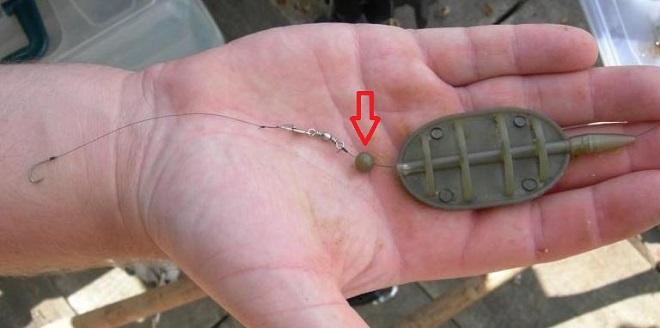
Inline equipment
Carp rig on icecore
For targeted fishing of large carp, carp or carp, flat feeder equipment can be placed not on the main line or shock leader, but on a piece of special braided material with a heavy core - icecore - tied to them. Icecore, due to its large diameter, does not penetrate under the scales or gill covers of the fish during fishing and does not injure it. For mounting the leadcore, or more precisely, forming loops on it for attaching the leash to the main line. You need the ability to work with this material and a special needle for installation. Read more about installation based on ledcore.
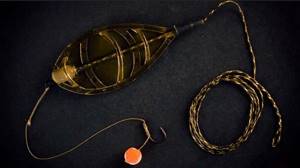
Elastic mounting
To catch cautious fish in clear water, it is sometimes necessary to use thin leashes. However, a short thin leash does not absorb shock, and a sufficiently large fish, when jerking, can tear off its feeder frame. In such conditions, special Elasticated flat feeders are used with a blind attachment to the main line and a rubber insert in the channel or directly along the body. One end of such a feeder is attached to the feeder, and a leash is attached to the other in a ring. This system absorbs the jerks of the fish on the leash and prevents it from breaking the equipment. During the fishing process, you need to monitor the condition of the elastic, and replace it if damaged or worn out.
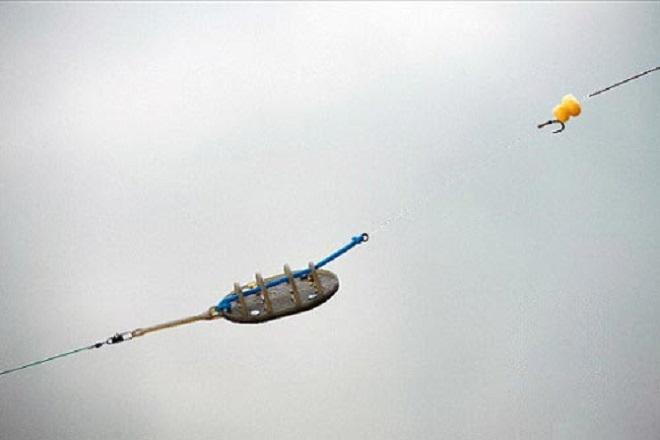
Hooking and landing fish
In case of a bite, the prey is hooked and fished out. If this is a trophy fish that rarely travels in schools and is easy to spook, it is better to immediately move the fishing to another feeding point, and additionally feed the one where there was a bite with a slingshot. Later, the fish will stand on it, and it will be possible to continue fishing there. If the fish are small, of which there are many throughout the reservoir, then fishing can be continued from the same place.
If there is no bite, they first try to adjust the bait. This often works when fishing for crucian carp - it changes its preferences from hour to hour, especially in the summer heat. If the bait does not work, try changing the fishing point. If this does not help, you need to try changing the composition of the bait that is stuffed into the feeder. To do this, you need to have at least three bait mixtures in your arsenal to stuff into the feeder, especially on an unfamiliar body of water. They may differ in composition from the starter mixture. It is better to prepare them in small quantities.
Victoria Leshchenko
I've been working hard in the fishing tackle department for the past six years. I can help you assemble almost any gear.
Ask a Question
Gradually they try all the options and get a bite.
Shock leader
You can use ready-made shock leaders, or you can use a braided cord with a diameter of 0.16-018mm and a length of two rod lengths.
The shock leader is necessary in order to compensate for the excess load on the main line during power casting, as well as to ensure comfortable landing of large fish in the last meters before the shore.
When choosing the thickness of the shock leader, you should also be guided by the diameter of the rod’s guide rings, especially on a quivertip. The main line is connected to the shock leader using a carrot knot, which is well known, or a counter knot.
Banjo fishing
It can also be classified as fishing on a feeder with a flat feeder. While a method feeder is an open structure with a flat, closed bottom, a banjo feeder is a feeder that is open on only one side. It is more effective if used in overgrown reservoirs, where the bottom is covered with a thick layer of elodea and hornwort. When using such a feeder, the food is not sprayed deep into the algae, where it is difficult for the fish to see. However, the feeding spot in this case is almost completely absent. However, this method is more effective than fishing without a feeder at all, and allows you to save the hook from getting caught by sticking it inside the feeder.
The banjo should be filled with a viscous mixture with the addition of pellets. The main requirement for bait is a fairly strong smell, since it will not be possible to attract fish with a large feeding spot when fishing with a banjo, and the food is usually located inside the feeder. As bait, you can use boilies, micro boilies, boilies with a worm or maggot attached to the hook, and even use foam balls with the addition of an attractant. Such experiments allow you to get bites from the most cautious and well-fed fish. On an overgrown or heavily silted bottom, a pop-up bait will have an advantage, since it is most visible to the fish and does not get tangled in algae. It will also have more advantages when fishing on heavily silted bottoms.
You can ask your question to our author:
Feeders for flat feeders
The flat method is a branch of method feeder fishing. In addition to, in fact, flat feeders, similarly, classic petal method designs, banjos or scoops can be used on this tackle. However, it is the flat shape with a flat sole that many anglers have fallen in love with in our country. The main advantage of such feeders is the flat bottom, which always falls down when immersed, the bait remains at the top. Flat is a further development of method petals with offset loading. The flat does not sink into the mud, correctly offering the fish a pile of bait and bait in it. All this in total makes the installation of the flat method so catchy in conditions of silted and mud-covered reservoirs. Read more about the types of flat feeders.

